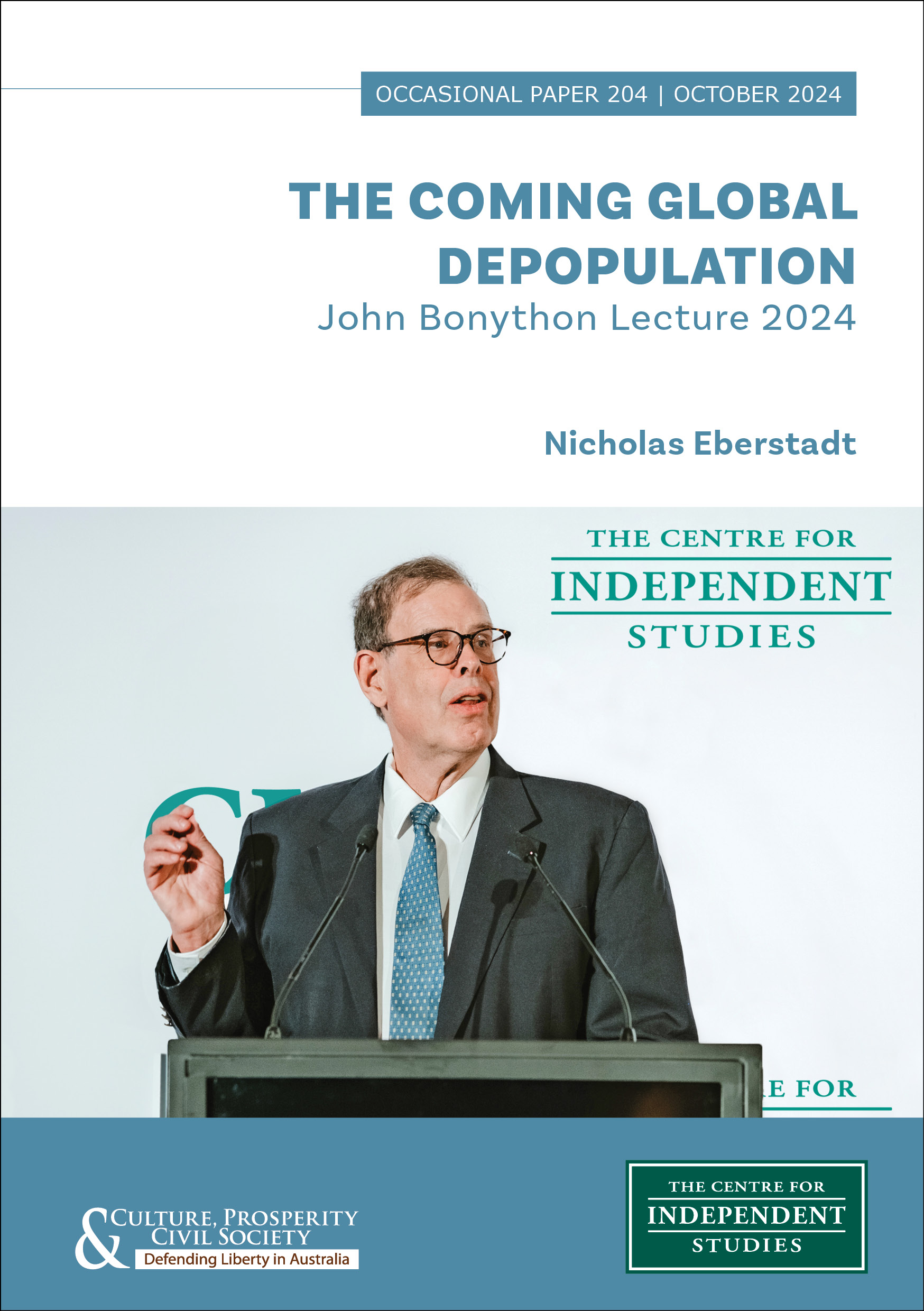
Foreword
In the late 1960s, Stanford University biologist Paul Ehrlich published an influential book. The Population Bomb began with these words: “The battle to feed all humanity is over. In the 1970s, the world will undergo famines — hundreds of millions of people will starve to death.”
Erhlich linked the population explosion to other possible scenarios of apocalypse: India would be doomed; England would disappear by the year 2000; US life expectancy would drop to 42 years by 1980. Humanity, it was asserted, was exceeding the Earth’s “carrying capacity”. Every ill, it seemed, was the result of exploding populations across the globe.
The book sold 3 million copies, and Erhlich’s thesis helped define the intellectual climate of the era. In 1970, Harvard biologist George Wald warned: “Civilisation will end within 15 or 30 years unless immediate action is taken to reduce population growth.” In 1972, the Club of Rome predicted the world would run out of gold, tin, mercury, silver and oil within two decades. Robert McNamara, the then-World Bank president, likened “rampant population growth” to thermonuclear holocaust, which justified throwing tens of millions of tax dollars into state-mandated population control.
None of these doomsday scenarios came to pass. Human ingenuity, economic growth and technological progress saved the day. More people have lived longer and more prosperous lives. Poverty across the globe has fallen dramatically. England is certainly battered and bruised, but Old Blighty is still there.
Yet in recent times, an intriguing development has taken place: global population growth is shifting towards population decline. With birth rates plummeting, more and more societies are heading into an era of pervasive and indefinite depopulation.
What lies ahead? What will depopulation mean for society, the economy, politics and international relations?
As one of the world’s leading experts on demography and a prolific contributor to America’s most distinguished publications, Nicholas Eberstadt is well-placed to address these issues. In September, CIS had the great honour to host his visit to Australia that culminated in the 2024 John Bonython Lecture.
As Nick concludes: “We will undoubtedly need our species’ trademark inventiveness and adaptability to cope with all the unintended future consequences of the family and fertility choices we are making today”.
Tom Switzer,
Executive director, Centre for Independent Studies
I
Although few yet see it coming, we are about to enter a new period of human history. Call it “the era of depopulation”. It is arriving quietly — catching most by surprise.
With birth rates plummeting all around the globe, more and more countries are moving into indefinite population decline, a phenomenon that will eventually encompass the entire planet.
What lies ahead is a world of shrinking and ageing societies. “Net mortality” — an excess of deaths over births — will be the new norm. With unrelenting super-low fertility, family structures and living arrangements previously imagined only in science fiction will become commonplace features of everyday life.
Our species has no collective memory of depopulation. Total human numbers have not declined for a very long time. The last long-term global depopulation was almost 700 years ago, in the wake of the Black Death.
We know what ended the last global depopulation: the procreative power of our species. We do not know what will end the next one. This time, depopulation will be due to humanity’s procreative power itself — or rather the want of it, thanks to revolutionary worldwide reductions in the desire for children.
All around the world, intellectual and policy circles are plainly unready for the new demographic order. Global population growth is the “background music” to our modern way of life. We take it for granted. Our social institutions, economic arrangements, and political dynamics presuppose it — rely upon it. We lack the intuitive coordinates to understand how prolonged depopulation will recast society, economy, and power politics. But recast these it most assuredly will.
II
The breathtaking sweep and scale of the worldwide march into sub-replacement fertility is not yet generally appreciated — even by demographic specialists. Grant me a few minutes to brief you on the seemingly unstoppable force pushing us closer and closer to global depopulation.
Ever since the heyday of the ‘population explosion’ in the 1960s, global fertility has trended steadily downward, as one country after another joined in the decline. According to the UN Population Division (UNPD), the world’s total fertility rate — the average number of births per woman per lifetime — was only half as high in 2015 as it was in 1965. By UNPD reckoning, every country saw birth rates drop over that period.
And the downswing just kept going — no matter how low birth rates were already. In recent years, the birth plunge not only continued, but quickened.
As a general rule of thumb, about 2.1 births per woman are required for long-term population replacement. Today, however, the overwhelming majority of the world’s people live in countries with below-replacement fertility levels, patterns inherently incapable of sustaining long-term population stability.
Jaw-dropping fertility collapses have been taking place in rich and poor countries alike. A quick spin of the globe offers a startling picture.
Let’s start with East Asia. The entire region entered into depopulation in 2021. By 2022, every major country there was shrinking. Today fertility levels are 40 per cent below replacement in Japan, 50 per cent below replacement in China, almost 60 per cent below replacement in Taiwan, and an astonishing 65 per cent below replacement in South Korea.
Next, Southeast Asia: that region tipped below replacement around 2018. Brunei, Indonesia, Malaysia, Singapore, Thailand, Vietnam — all now members of the sub-replacement club. Predominantly Catholic Philippines is sub-replacement too. Even impoverished, war-riven Myanmar’s birth rate is below replacement.
In South Asia, sub-replacement fertility already prevails in India, Sri Lanka and Nepal. Bangladesh is on the verge of sub-replacement, too. Urban India’s fertility levels are just about as low as Europe’s. Vast Kolkata is down to an amazing one birth per woman: lower than any major European city.
Latin America and the Caribbean is yet another sub-replacement zone. Super-low birth rates are no longer unusual there. Fertility has dropped below one birth per woman in sprawling Bogota. It is also under 1 birth per woman in Mexico City.
Sub-replacement fertility has even come to North Africa and the greater Middle East, where Islamic faith was long assumed to be a bulwark against precipitous declines in childbearing. Iran has been a sub-replacement society for about a quarter century. In sub-replacement Turkey, birth levels today are lower in Istanbul than in Berlin.
In Europe, of course, fertility has been sub-replacement for almost half a century. Like the Russian Federation, the European Union is now a net mortality zone. Last year France tallied fewer births than in 1806, when Napoleon won the battle of Jena. According to UNPD, the continent entered into long-term population decline in 2020.
The USA remains the main outlier among developed countries resisting the gravitational pull of depopulation. But even there, depopulation is no longer unthinkable. The US Census Bureau now projects that America’s population could peak around 2080, with continuous declines thereafter.
The only major remaining bastion against the global wave of sub-replacement is sub-Saharan Africa. With its roughly 1.2 billion people, and a fertility rate of over 4 babies per woman, the region is the planet’s last consequential redoubt of ‘population explosion’-style childbearing.
But even there things are changing. Fertility in sub-Saharan Africa has already fallen by a third since the days of the ‘population explosion’. In South Africa, birth levels are just fractionally above replacement, with other southern African countries following close behind. Off the African coast, Mauritius and Cabo Verde are already sub-replacement.
It is possible — not certain, but possible — that humanity as a whole has already dropped below replacement on a global level. We can’t tell yet, owing to the lack of up-to-date data for sub-Saharan Africa.
Nevertheless, it is apparent that worldwide sub-replacement fertility — the precondition for global depopulation — is set to commence very much sooner than most demographers would have imagined even a few years ago. And for a quarter of the world, population decline is actually underway, right now.
III
What accounts for this extraordinary worldwide march into sub-replacement? Truth be told: this most important of all modern social movements still remains mysterious to those of us who study it.
Nonsense, you say: Economic development and material advance explain the world’s slide into super-low birth rates and national population decline. Right? Not so fast.
Myanmar and Nepal are impoverished, UN-designated “Least Developed Countries”: but they are also sub-replacement societies. And there are fascinating, rule-thwarting, exceptions for virtually every other generalisation about the possible determinants of fertility decline, too.
Eventually, though, economist Lant Pritchett identified the most powerful national fertility predictor of them all. That decisive factor turned out to be: the number of children women say they want. Around the world and over time, there is an almost one-to-one correspondence here.
Human agency! Who would have guessed? But if volition shapes birth rates, what explains the sudden worldwide dive into sub-replacement territory, in rich and poor countries alike?
The genius who finally answers that question will deserve a Nobel. But in literature, not economics. He or she will have to channel the global Zeitgeist; chart the shifting coastlines of the modern mentality; and explore secrets hidden in billions of human hearts. Social science can only take us so far in any of this. Nevertheless, a few observations and speculations may nonetheless already be in order.
First: a revolution in the family — in family formation, not just childbearing — is clearly underway around the world, in rich countries and poor ones, across cultural traditions and value systems. Symptoms include the ‘flight from marriage’; the spread of cohabitation and temporary unions; and the rise of one-person homes — i.e., living alone.
Further: young men and women everywhere seem increasingly to prize autonomy, self-actualisation, and convenience — and children, for their many joys, are quintessentially inconvenient.
Finally, a fact that may also be a clue: there is as yet no modern case of a country that has returned to replacement levels of childbearing, even briefly, after dipping into very steep sub-replacement territory (say, 30 or 35 per cent below replacement).
Today’s population trends should raise serious questions about all the old nostrums from ‘socio-biology’ that humans are somehow ‘hard-wired’ to replace themselves to continue the species.
Conversely, ‘mimetic’ theory, which stresses the role of volition and ‘social learning’, might merit closer scrutiny for what it can reveal about family formation and babies.
Public intellectual Mary Eberstadt describes ‘social learning’ loss as the “cat stuck in the tree” problem. Those kittens rescued by fire departments seem invariably to be pets who did not live around (or learn to climb from) others of their kind.
So too perhaps with humans and their fertility patterns: it may prove very much easier for humans to choose to enter a prolonged low fertility regimen than to choose to return to larger families.
IV
A depopulating future will be sharply different from the present in a number of obvious respects. By 2050, in some UNPD projections, about five-eighths of the world’s people could be living in net-mortality zones. Latin America and Southeast Asia would be among the new net-mortality spots; so too India, Iran, and Turkey. Net mortality would also be emerging by then in Sub-Saharan Africa, starting with South Africa. Once a country enters into net mortality, only continued, ever increasing, immigration can stave off long-term population decline.
Labour forces will shrink due to the spread of sub-replacement. By 2050, two thirds of the planet’s population could live in countries with dwindling working-age populations.
A depopulating world will be an ageing one. Perhaps counterintuitively, fertility levels have a much more powerful impact on social ageing than longevity — so the global march to low fertility, and now to super-low birth rates, is generating a worldwide wave of top-heavy population pyramids, where the old begin to outnumber the young. Positively aged societies will soon become the global norm.
By 2050, outside the sub-Sahara, there will be hundreds of millions fewer people under the age 60 than today — but the numbers of seniors will be exploding. The upsurge in the ‘super-old’ — the 80+ contingent — will be even more rapid. Just between today and 2050, that group is on track to nearly triple.
The shape of things to come is most mind-bendingly suggested by projections for countries at the vanguard of tomorrow’s depopulation: places with severely low birth rates, plus favourable life expectancy trends.
Consider China. By 2050 China’s median age will be somewhere above 50. The working age population will be 25 per cent smaller than 2020. Nearly a third of China will be 65 or older. One in ten will be 80 or older.
It is South Korea, however, that provides the most stunning vision of a depopulating future. Current projections suggest South Korea will be commemorating three deaths for each birth by 2050. In some projections, the ROK’s median age could approach 60. Over 40 per cent of the country could be senior citizens, and one in six could be over 80.
This is what we see on the transition to depopulation. Then comes steady state population decline.
Should South Korea’s current fertility trends persist, the country’s population could continue to decline by over 3 per cent per year, crashing by 95 per cent over the course of a century.
V
This next chapter for humanity may sound ominous, even frightening. But even in an ageing, shrinking world, steadily improving living standards and material and technological advances will still be possible. This crucial point must be underscored, if only to counter unwarranted demographic pessimism.
Demographic pessimism, after all, has long been something of a default position in learned circles.
Not so long ago, pundits were panicking about the ‘population explosion’, prophesying mass starvation due to childbearing in poor countries. In hindsight, those fears look bizarrely overblown. Despite tremendous population growth over the past century, the planet is far richer and far better fed than ever before.
The same formula that spread prosperity in the 20th century can ensure further advances in the 21st and beyond — even in a world marked by depopulation.
The essence of modern economic development is the unchaining of human potential. Human capital and business climate are the keys to boundless wealth generation.
Improvements in health, education, science and technology fuel the motor for material advance. Irrespective of demographic shrinking and ageing, societies can still make gains across the board in these.
Remember: the limits of human longevity are not yet known. Life expectancy at birth in the world’s longest-lived countries has been heading upward for nearly two centuries on an almost perfectly straight trajectory, rising by about three months per year. Still is. Remarkable, but true.
Part of what is lengthening lives is the power of education. The world has never been as widely and deeply schooled as it is today, and there is no reason to expect the rise in training to stop, given the immense gains that accrue from education to both societies and trainees themselves.
Remarkable improvements in health and education around the world speak to the application of scientific and social knowledge — the stock of which has been relentlessly advancing thanks to human inquiry and innovation. That drive will not stop now.
So even an elderly, depopulating world can grow increasingly affluent.
There is no guarantee: war, ill-considered political decisions, or other manmade disasters could sabotage it. But an ever more prosperous future is ours to lose.
Yet as societies assume new structures under long-term population decline — as the old population pyramid is turned on its head — people will need new habits of mind, conventions, and cooperative objectives.
Communities, businesses and governments will have to learn new rules for development under depopulation. Policymakers and researchers will need to amass a corpus of practical knowledge about economic, fiscal, and monetary management for ageing and shrinking populations. Investors, likewise, will need new playbooks to profit from an altered environment of opportunity and risk.
In depopulating societies, today’s ‘pay-as-you go’ social programs for national pension and old-age health care will eventually fail as the working population shrinks and elderly claimants balloon. Current incentives are seriously misaligned for the advent of depopulation. But policy reforms and private sector responses can hasten necessary realignments.
To adapt successfully to a depopulating world, states, businesses, and individuals will have to place a premium on responsibility and savings.
As people live longer and are healthier into their advanced years, they will retire later. Voluntary economic activity at ever-older ages will make life-long learning imperative.
Prosperity in a depopulating world will also depend on open economies: free trade in goods, services, and finance to counter the constraints that shrinking populations otherwise engender.
And as the hunger for scarce talent becomes more acute, the movement of people will take on new economic salience: in the shadow of depopulation, immigration will matter even more than it does today.
Not all aged societies, however, will be capable of assimilating immigrants. And not all world-be migrants will be capable of contributing to receiving economies, especially given the stark lack of skills characterising too many in rapidly growing populations nowadays.
Competitive immigration policies will offer promise even when all countries are shrinking — indeed, the value of attracting talent from abroad then stands only to increase. Getting competitive migration policies right — and securing public support for them — promises be a major task for future governments, but one well worth the effort. (Australia, may I add, looks to be well positioned for the future in this regard — and in others as well.)
VI
Depopulation will not only transform how governments deal with their citizens; it will also transform how they deal with one another. Humanity’s shrinking ranks will inexorably alter the current global balance of power and strain the existing world order.
Some of the ways it will do so are relatively easy to foresee today. But depopulation is also going to scramble geopolitics in ways we cannot yet predict.
One of the demographic certainties about the generation ahead is that differentials in population growth will make for rapid shifts in the relative size of the world’s major regions. Tomorrow will be much more African. A seventh of the world’s population today lives in the sub-Sahara, but the region accounts for nearly a third of all births. Its share of world manpower and population are thus set to grow immensely.
But that does not necessarily mean an African Century lies just ahead. In a world where per capita output can varies by as much as a factor of 100 between countries, human capital matters greatly to national power — not just headcounts. The outlook for human capital in sub-Saharan Africa remains disappointing. According to standardized testing, in fact, a stunning 94 per cent of youth in the region lack even basic skills.
India is now the world’s most populous country, on track to grow further for at least another few decades. Its demographics virtually assure that the country will be a major power in 2050. But India’s rise is also compromised by human resource vulnerabilities. India has a world-class cadre of scientists, technicians, and elite graduates. But education for ordinary Indians lags woefully behind. A shocking seven out of eight young people in India today lack basic skills. The skills profile for China’s youth is decades, maybe generations, ahead of India’s today. So India is unlikely to surpass a depopulating China economically for a long time.
A coalescing partnership between China, Iran, North Korea, and Russia is intent on challenging the US-led Western order. These revisionist countries have ambitious, aggressive leadership, seemingly confident in their international objectives. But the demographic tides run against them.
Russia and China are longstanding sub-replacement societies, both now with shrinking manpower and declining populations. Iran is likewise far below replacement levels. Population data on North Korea remain state secrets, but Kim Jong-Un’s very public worrying about the national birth rate suggests he is not happy about the country’s demographics.
That does not mean that Washington and her allies can be complacent. The real world is replete with greying and depopulating states that rely on brinkmanship and confrontation. One of them, Russia, recently launched an unprovoked invasion of Ukraine. Another, China, is very publicly planning a campaign of coercion against its neighbor Taiwan. Assuring the success of deterrence will remain imperative in a depopulating world, too.
As for the United States, demographic fundamentals look fairly sound—at least by comparison to the competition. Demographic trends are on course to augment American power over the decades immediately ahead, lending support for continuing U.S. global preeminence. Given the domestic tensions and social strains that Americans are living through today—and the general decline back home in trust and confidence in the country and its institutions—these long-term American advantages may come as a surprise. But they are already beginning to be taken into account by observers and actors abroad.
Thanks in no small measure to immigration, the US is on track to account for a growing share of the rich world’s labour force, youth, and highly educated talent. No other country on earth is better placed to translate population potential into national power—and that demographic edge could be at least as great in 2050.
Compared to contenders, in short, U.S. demographics look strong today and might look even better tomorrow—pending, it must be emphasized, continuing public support for immigration. The United States remains the most important geopolitical exception to the coming depopulation, at least for the next generation or so. (Australia, of course, is likewise a great exception.)
But depopulation is also going to affect the balance power in ways we cannot yet foresee. Two unknowns stand out above all others: how swiftly and adeptly depopulators will adapt to their unfamiliar new circumstances, and how prolonged depopulation might affect national will and morale.
Nothing guarantees that societies will successfully navigate the turbulence caused by depopulation. Achieving economic and social advance despite depopulation will require substantial reforms in government policies, the corporate sector, social institutions, and personal norms and behavior as well. Far less heroic reform programs fail all the time in our current world.
The majority of the world’s GDP today is generated by countries that will be grappling with depopulation a generation from now. Depopulating societies that fail to pivot will pay a price. If enough depopulating societies fail to pivot, their struggles will drag down the global economy. The nightmare scenario would be a zone of important but depopulating economies, accounting for much of the world’s output, frozen by pessimism, anxiety, and resistance to reform into sclerosis or decline.
Even if depopulating societies eventually adapt successfully to their new circumstances, as we might reasonably expect, there is no guarantee they will do so on the timetable that new population trends demand.
Another immense strategic unknown is whether pervasive ageing, anemic birth rates, and prolonged depopulation will affect the readiness of shrinking societies to defend themselves and their willingness to sustain casualties in doing so. Despite all the innovations changing the face of battle, there is still no substitute in war for warm (and vulnerable) bodies.
Defense of one’s country cannot be undertaken without sacrifices—including, sometimes, the ultimate sacrifice. But the “flight from the family” underway throughout the rich world today is manifestly a flight from sacrifice, too.
On the other hand, it is also possible that many people (especially young men) with few familial bonds or obligations might be less risk averse, hungry for the kind of community, belonging, and sense of purpose that military service might offer.
Casualty tolerance in depopulating countries may depend greatly on unforeseen contingent conditions—and may surprise.
The Russian invasion of Ukraine provided a test. Both countries were already long-established de-populators on the eve of the invasion. And both the authoritarian aggressor and democratic defender have proved willing to absorb grievous casualties in a war now grinding into its third year.
China presents perhaps the biggest question mark when it comes to depopulation and willingness to fight. Today and tomorrow, China’s military will perforce be staffed in large part by men raised as “only children.” A mass-casualty event would have devastating consequences for families across the country, bring entire lineages to an end.
It seems reasonable to wager that China would fight ferociously against a foreign invasion. But such casualty tolerance might not extend to overseas adventures and expeditionary journeys that go awry.
If severely sub-replacement China eventually decides to undertake a costly campaign against Taiwan, the world could learn something grim about what may lie ahead in the age of depopulation.
VII
To conclude: depopulation will transform our world profoundly, likely in numerous ways we have not begun to consider and may not yet be in a position to understand.
Yet for all the momentous changes ahead, we can also expect important and perhaps reassuring continuities. Humanity has already found the formula for banishing material scarcity and engineering ever greater prosperity. That formula can work regardless of whether populations rise or fall. Human volition—the driver behind today’s worldwide declines in childbearing—stands to be no less powerful a force tomorrow than it is today.
Humanity bestrides the planet, explores the cosmos, and continues to reshape itself because we are the world’s most inventive, and adaptable, of animals.
We will undoubtedly need our species’ trademark inventiveness and adaptability to cope with all the unintended future consequences of the family and fertility choices we are making today.
Thank you.
Q&A
Tom Switzer:
Now comes a fun bit where we try to challenge Nick’s thesis. And I have to say just from the outset, Nick, the numbers are striking, especially Northeast Asia, Taiwan, South Korea — less than one child.
Nicholas Eberstadt:
Yes, really low.
Tom:
But we’ve seen this story a bit before though, with Japan in the 1970s. There was a lot of doom and gloom about Japan’s demographic death spiral in the 1970s. And Japan remains one of the world’s largest economies. It’s not been the disaster that many people imagined. So can we take hope that perhaps the same thing might apply to Taiwan, South Korea and the so-called Asian Tigers of Northeast Asia?
Nicholas:
Well, Tom, as I tried to argue, it’s possible for depopulating societies to maintain and improve their prosperity, and I hope they’re going to. We’ve got some room for hope from what we’ve been seeing in Japan, which is the longest standing depopulator at this point. There’s one thing I didn’t mention though, which I thought would get us down too much of a rabbit hole. What we’re seeing now in Japan, like we’re going to see elsewhere, is the implosion of the family structure. In Japan today, a woman born in 1990 has about even odds of living to see any biological grandchildren, given marriage and childbearing patterns. I don’t think we know yet what a society is going to operate like when there’s pervasive childlessness and a lack of family support. That may turn out to be the biggest challenge of all.
Tom:
There is a school of thought that says managed population decline is not only desirable, but it’s essential to our long-term survival. And the argument goes like this: that fewer humans mean fewer demands on everything from fish to farmland to fossil fuel emissions that create climate change. In other words, shrink the economy to save the world. How do you respond to that?
Nicholas:
Well, if you don’t like having people around you, you’re in luck. Just wait around a little bit. I think that of course it’s true that with smaller populations, there’ll be more land per person, there’ll be more area per person in the world. It’s not clear to me that depopulation is the key to saving the planet though. I think that human ingenuity is the key to saving the planet.
Tom:
Well, human ingenuity, economic growth — that has unquestionably helped reduce poverty all around the world in the last few decades. But our critics say it has hardly delivered equality. This is a recent Guardian Australia report. And I think, as I often say at CIS events, it’s important to know what our critics say because then you know our own weaknesses. The report says: “Statistics show the largest benefits from economic growth overwhelmingly ends up in the pockets of the already rich. And endless economic growth is inextricably tied to consumption, which in turn is disrupting the parallel push for sustainability.”
Nicholas:
There are a lot of different ways of measuring inequality. My favourite way is the inequality between being alive and being dead. And one of the remarkable and unexamined phenomena with the explosion of health around the world has been the change in the distribution of years of life on the planet. If you did the same sort of Gini coefficient that you hear about on income for Gini coefficient on years of life, age at death, you’d find that the inequality in lifespans has radically shrunk over the course of the 20th century and is continuing to shrink. That’s why the gap in life expectancy between rich and poor countries is shrinking. By the same token, the distribution of years of schooling all around the world is also shrinking pervasively and systematically with the improvements in mean years of schooling around the world. I think we’re seeing a lot of evidence that by things that matter to human beings, inequality is diminishing, not increasing. And just look, one final thing at what’s happening in the estimates of extreme poverty around the world. Tom, you mentioned that I didn’t think I would live to see the day where extreme poverty in India is down below 1%. I think people in India would probably think that’s pretty good.
Tom:
Yes. But again, our critics would say, or some of them at least would say that the fertility crisis is bogus. John Quiggin — who has been a professor at the University of Queensland for many years, he was a columnist at the Financial Review, a man of the left — says that the fertility crisis is bogus. And in his judgment, it’s not just because policies to address it appear to be universally failing. This is his quote. “Economically, the cost of raising children is much higher than the cost of looking after old people. The odds are you’ll be in a reasonable shape until about six months before you die, at which point you’ll need about the same care as a baby.” And Professor Quiggin concludes: “So raising a baby to look after an old person makes no sense.” Following on from that, the question here is whether the cost of raising a child is way more than the cost of putting someone in aged care?
Nicholas:
I don’t know how it works in Australia, but I can tell you that in the United States, there have been a lot of studies on consumption by age, by year of life. And consumption by the old is consistently significantly higher than consumption by the young. So I don’t know that his arithmetic works particularly in the United States. I would say, however, that the real point with regard to costs of childbearing concern priorities — if you look at the United States, if you look at Europe, I suspect if you look at Australia — people have never had as much income as they have today. They’ve never had as much housing space as they have today. They’ve never had as many cars as they have today. They’ve never had as many vacations as they have today. It’s just one thing that they have fewer of: that’s children. And that doesn’t tell me just by looking at those facts that this is a question of affordability. It looks like a question of priorities.
Tom:
Yes, and context is important. If you go back to the early 1960s, the fertility rate here in this country was about 3.5. Today it’s about 1.6, maybe 1.8. It did get up to 2 to 2.5, I think, in the 2000s — primarily, some would argue, because of the Howard/Costello government’s policy on the baby bonus. But we’ve also had paid maternity leave. We have various family tax benefit allowances, subsidized child care. Now, one of our economists, Robert Carling talks about there being about five or six areas of government spending as a percentage of GDP that are going through the roof. We all know about NDIS — our national disability program — Gonski schools funding, aged care, and child care is one of them as well. So we do a lot here to help address this issue. But what else do you think our political leaders and policymakers should do to help boost fertility?
Nicholas:
The most fundamental thing that government policy can do is to help populations become as rich as fast as they can, and people can decide what they’re going to do with their own money. The record of pro-natal policies around the world, as I read it, is well-meaning perhaps, but very expensive for very modest, long-term demographic gains — for a reason that I mentioned. Namely, Lant Pritchett’s observation that the most important determinant of family size is the number of children that people want to have. If you had a government ministry that tried to change people’s minds about how many children they wanted to have, you might end up with some successes, but that sounds a little scary to me.
Tom:
Just keeping on the subject of fertility before we talk about geopolitics. Many people would not surprisingly say that Islamic faith — and I think you mentioned this in your lecture — is a bulwark against precipitous declines in childbearing. And indeed, if you look at Muslim communities in Europe and in Australia, the fertility rates among Muslim families are a lot higher than they are among non-Muslim families. So, to the extent that’s true, should western nations like Australia in coming decades expect a huge immigration intake from not just sub-Saharan Africa that you highlighted in your lecture, but also the Sunni and Shia Muslim parts of the Persian Gulf and the Middle East?
Nicholas:
So many things that are surprising about population trends because the theory in demography is so weak and human beings are so inventive. One of the things I found surprising was how rapidly birth rates are dropping in the Ummah — the whole community of Muslims bound together by ties of religion. I mean, 7 of the 10 fastest 20-year drops in birth rates that I could find in the post-war era were Muslim-majority countries, including places in the Gulf, including Iran.
Tom:
That’s fascinating.
Nicholas:
And it’s not because they were having Taiwan-style socio-economic modernization. It’s because there’s a change in mentality that was occurring despite the teachings.
Tom:
So to the extent you are right, that means we shouldn’t expect a huge influx of Muslim immigrants with immigration?
Nicholas:
There may be people who want to come to Australia, but I think if you have a skills-based policy — as I read your documents — you’ll be able to decide who are going to be the skilled people that should be contributing to your future.
Tom:
Now following on from immigration, there’s a growing movement in this country that supports slashing immigration to, among other things, address our housing affordability crisis. Our chief economist in this area, Peter Tulip, disagrees with that argument, but nevertheless, there is a movement growing in this country to slash immigration to help address a housing crisis in our cities. Now, you said in your lecture that Australia is well positioned for the future. Tell us more.
Nicholas:
Well, if you are successful in bringing in talent from abroad, you are going to be creating at least the possibility of unlocking value of human resources in your own country. What will that do? At the very least, postpone the crisis of the existing welfare state, but it may do many more things for growth and for dynamism in your society. We have a big problem in the United States on our southern border at the moment that I don’t think is exactly a secret. And what concerns me the most about that honestly, is I think that if I were trying to design an event or a policy that would poison American sentiment against continuing positive immigration, I don’t think you could do much better than what’s going on there. The United States has benefited immensely from immigration over the entirety of its history, and you don’t have to be a Horatio Alger about this. There are always a lot of problems with assimilation. There’s always a lot of pains with it. But the benefits of immigration for the United States, I think have clearly exceeded the costs, at least to date. And I’d be surprised if that isn’t the case for Australia as well.
Tom:
Okay, we’ll talk about America very soon, but let’s just put your thesis in a geopolitical context and start with China. You say that one consequence of depopulation, Nick, is that the long-heralded China-led Asian Century may never truly arrive. You made this point in Foreign Affairs magazine a few months ago. But the Chinese Communist Party officials would say that they’ve got it under control because of artificial intelligence, robotics, information technology, and — taken together with the end of the one child policy that had been in place since the 1980s — that means China will actually boost its demographic levels in coming decades. How would you respond to the Chinese Communist Party?
Nicholas:
I tried to argue today that technological innovation, better health and education, mean that a shrinking ageing society can maintain and improve prosperity, and one would hope that that could happen for China as well. It helps to have a positive business climate. The business climate is essential to unlocking the value of human resources, and certainly what we’ve seen over the last decade in China has been a retrogression in business climate. I don’t want to get too much into the weeds on that, but I don’t think it’s really great for business climate to establish a Communist Party celll in every western business. So it’s not clear to me that the CCP at the moment is more interested in economic flourishing than political control. If it were more interested in economic flourishing, I think there’d be more potential.
Tom:
But what about the retirement age in China? Let’s go through some of these figures reported in the South China Morning Post. The legal retirement age for men in mainland China is 60, for women it’s 55 for white-collar workers, and 50 for blue-collar workers. Now, those ages have been unchanged for more than 70 years. So, if the CCP redefines working age to include older people and improve the participation rate in the labour market, won’t China be better able to address the demographic crisis?
Nicholas:
It sounds like it should. If one reads like the Soviet constitution upon which those guarantees were based originally by Mao in the ’50s, the problem is that the guarantees only apply to a very small portion of the Chinese labour market, to the state-owned enterprises, and to some of the municipalities. A fifth, maybe a quarter of the entire population. If you look at the workforce participation in China by age, it’s about the same as in Japan. It’s about the same as in the USA. Which is to say that, even at older ages, quite a few people in China are working more than in Europe, for example. I don’t think there’s that much scope for increasing that.
Tom:
If you’re right, if this demographic death spiral continues in China, could we expect to see these countries like China and Russia seek military solutions to their demographic problems? In other words, could their awareness of the demographic doom loop make them more desperate and therefore more dangerous?
Nicholas:
Oh, I think very definitely so. I mean, there is a school of thought in the academy about what’s called ‘geriatric peace’. It contends that as countries become greyer, they become more risk-averse. And I think if the country you’re studying is Belgium, that’s probably true. But I don’t think that works quite as well with Putin’s Russia or with Xi Jinping’s China. For autocracies, you can see a lot of reasons that they might become more skittish, more aware of vulnerabilities, including domestic vulnerabilities, with ageing and shrinking. We do have a conflict now with an ageing, shrinking Russia, and we do see a coercion campaign — not an invasion, but a coercion campaign — underway with an ageing, shrinking China.
Tom:
But Ukraine has lower birth rates than Russia. And Ukraine, of course, is outmanned and outgunned on the battlefield. So, what does this mean for Ukraine?
Nicholas:
Ukraine’s got a very tough situation. I was there a few months ago. I’ve been paying attention to what human resources would look like in an eventual reconstruction of the country. And part of the problem for Ukraine is that, in some ways, their human resource situation is more Russian than Russia’s. They have, as you say, very low fertility. They’ve got big health problems. They have this paradox, just as Russia has, of seemingly high education, but low human capital with poor health and poor knowledge production. So, there’s a big challenge ahead for Ukraine after the war ends.
Tom:
Now, on the United States, you’re obviously a bit upbeat about America in your lecture. You talk about the fairly sound demographic fundamentals, but there are negative trends eating away at the foundations of US power. And I want to put to you the views of Kishore Mahbubani, the distinguished Singaporean intellectual — and a past guest at CIS. US life expectancy has been dropping for much of the past decade. US progress in public health indicators have been painfully slow and very expensive. Improvements in educational attainment have stalled in the US in recent decades. US fertility rates have been falling in recent decades. Failure to defend and secure America’s southern border as 2 million migrants from all over the world pulled across. You acknowledge that. And that’s not to mention the problem with debt. Now, Niall Ferguson, the distinguished Scottish historian, who’s our guest at Consilium in October on the Gold Coast (www.Consilium.org.au) makes the point that a great power that spends more on servicing its debt than on defence won’t remain great for long. So, given all of that, is your optimism about America misplaced?
Nicholas:
I think that there are a number of pressing problems that the United States faces, and I’ve written about them myself. In 2017, I wrote a piece called Our Miserable 20th Century, where I tried to do a diagnosis of these different human resource problems. And more recently, I did a little book called Lessons for an Unserious Superpower. I’m trying to, in a loving sort of way, explain to others in Washington maybe how they ought to grow up a little bit about some of the problems we’re facing, including most specifically the budgetary problems. Are these things that I’d want for my country? No, not at all. Are they fatal derailers? I think the budgetary thing could eventually be a fatal derailer. I think they could. I think Niall is exactly right; that if there’s no attention paid eventually to the US public finances, we know what’s going to happen.
Tom:
The US is still a reserve currency.
Nicholas:
There’s a lot of room for fecklessness — and we’ve used quite a bit of it, but there’s still more. But the single greatest problem, I would think, is if the US public becomes poisoned and hardened to immigration in the future. Because so far immigration has been an ace card for us and a saving grace. And we’ve benefited despite our absolutely shambolic immigration policy. It seems almost as if we can’t help it. We’ve been vacuuming up talent from around the world in a way that’s helped dynamise our economy. So, I’d say that compared to competitors — not compared to the ideal or compared to the way I would wish things to work in my country — compared to real existing competitors, the United States has the advantage. And would I or would Kishore want to trade the US hand for the Chinese hand? I don’t think so.
Tom:
One thing we’ve overlooked in this conversation is the toxic political polarisation in Washington. Now, a decade ago, you may remember, Robert Gates was the defence secretary under both Presidents Bush and Obama. He said a decade ago — before Trump even arrived on the scene — that the greatest national security threat to the United States wasn’t China or Russia or Sunni Jihadists, like Islamic State or Iran. The greatest national security threat to the United States, Gates said, was the two square miles between the Capitol building and the White House. In other words, that toxic political polarization. And in the last few months, we’ve had some distinguished scholars put forward some pretty disturbing theses. Robert Kagan, a neoconservative scholar at the Brookings Institution who actually gave the John Bonython Lecture here 20 years ago, says that a re-elected Donald Trump could create or bring about fascism in the United States. He’s not alone, but he’s a neocon. And then, you’ve got Ed Luce from the Financial Times, the prominent British columnist in Washington, who says that America could very well be on the cusp of a civil war. So, given this toxic polarization, these bitter divisions in American public life, if indeed the outcome of this upcoming presidential election contest is as exceedingly close as all the polls indicate it will be, could we face the biggest political and constitutional crisis since the Civil War in the 1860s?
Nicholas:
Even for people who have lived in the United States all their lives, including some pundits, the United States is a very hard country to understand. And the whole Reductio ad Hitlerum thing — the playing of the ‘Nazi’ card — that we’ve heard for the better part of the past decade, it seems to me as kind of hysterical and overblown. We have plenty of political problems in the United States, and there’s a great lack of trust in the United States. Part of this has to do with an empathy gap that has developed within my country where it seems to be, for some reason, exceedingly taxing for people in one political party to describe in a recognizable form what people in the other political party actually believe. And so, there’s less trust and too little respect in the contending factors.
Tom:
What does that mean for the body politic?
Nicholas:
Well, you have to go back to the Constitution. The Constitution is a doctrine which is designed to force people to negotiate with each other. It’s not a doctrine by which you are going to lead to enduring success by grandstanding in front of a limited constituency. It’s made naturally to find consensus. And unfortunately, in over the last generation or more, people have had a lot of incentive to avoid finding consensus. But the framework is there. And if we had, I guess, a little bit more grown-up leadership in the United States, I think we’d see the benefits.
Tom:
Well, on that note, it’s been a pleasure, Nick. Thank you very much.










